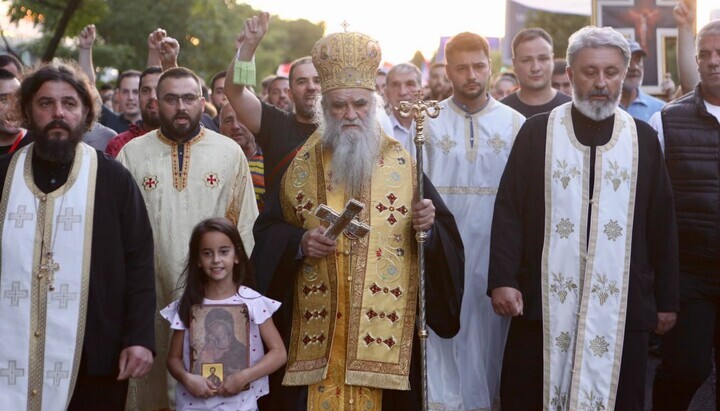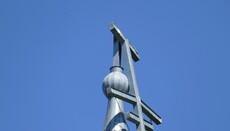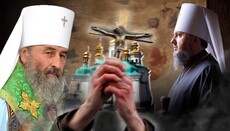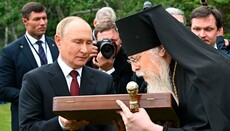Cold War Echoes: The Media’s Crusade Against Orthodox Christianity
![A Grotesque caricature of Orthodox hierarchs. [CREDIT: Kyiv Post]](/img/article/844/26_main-v1748971063.png)
A French court ruling exposes not just legal facts—but the Western media’s deep bias against canonical Orthodoxy.
On May 26, 2025, Le Monde published an article titled “Russia takes over a second Orthodox Church in Nice,” describing a recent French court ruling that returned the Saints Nicholas and Alexandra (Romanov) Orthodox Church in Nice to the Russian Orthodox Church (ROC).
The parish in question had previously been held by a schismatic émigré group unrecognized by any canonical Church.
Rather than presenting the case as a legal restoration of ecclesiastical property to its rightful canonical authority, Le Monde’s Moscow correspondent Benoît Vitkine frames it as a Kremlin-orchestrated hostile takeover.
If Le Monde once aspired to be seen as a neutral or reputable source, this piece shatters any such illusion.
Vitkine elevates the schismatic ACOR group as a French institution promoting “open religious practice,” in contrast to the ROC—portrayed in his telling as little more than an extension of Russian intelligence. He even claims that ROC hierarchs are “subject to the FSB, the security services, just as their predecessors in Soviet times were under the KGB.”
But if ecclesiastical proximity to national institutions is grounds for suspicion, where is Le Monde’s criticism of Serhii (Epiphany) Dumenko and the hierarchs of the state-backed “Orthodox Church of Ukraine” (OCU)? That organization has received overt support from the Ukrainian security services, the SBU—a successor to the KGB no less than the FSB.
Do Orthodox hierarchs in Russia cooperate with Russian authorities? Likely so—just as clerics in America, Greece, and elsewhere cooperate with their national governments. But while such collaboration in the West is labeled patriotism, in the Russian Church’s case, it is framed as subversion.
This narrative—Orthodox Christianity as a political threat—is becoming increasingly common in Western media.
A recent BBC article depicted the Russian Orthodox Church Outside of Russia (ROCOR) not as a Church, but as “a global network with headquarters in New York… expanding across parts of the US,” pushing pro-Putin, far-right propaganda. Those being baptized are not described as Christians or converts, but as “followers.”
This mirrors the rhetoric coming out of Kyiv regarding the Ukrainian Orthodox Church (UOC), which has faced growing persecution over the past eight years. Such framing is not only false—it is dangerous. It seeks to delegitimize centuries-old religious communities by redefining them as political operations, thus stripping their adherents of religious protections under the guise of national security.
Vitkine closes his article with a quote from a man named Obelensky, who laments that the only alternative place of worship is the local Serbian Church, which he claims is also under Moscow’s influence. This is not the first time the Serbian Church has been maligned by the media. During the Yugoslav Wars, American journalists portrayed the Serbian Orthodox Church as reactionary, superstitious, and complicit in genocide.
Unfortunately, the Western media apparatus has a long history of demonizing Orthodox Churches to weaponize public opinion—something Jim Jatras warned against in a 1997 article titled Pravoslavophobia, republished in his recent collection I Tried to Warn You.
What we are witnessing is the darker side of Orthodoxy’s recent growth in the West. Increased visibility has not been matched by increased public understanding. Instead, Orthodoxy has entered the spotlight at a time of geopolitical tension: two Orthodox nations at war, and the Greek Church—the most prominent Orthodox jurisdiction in America—closely aligned with U.S. political interests.
While the Greek Church has sown division and bloodshed through its support for the OCU, it is held up by the West as the “good Church.” Meanwhile, the Slavic Churches—comprising the overwhelming majority of the Orthodox world and remaining committed to canonical order—are branded political pariahs.
There was once an elder in Harbin who made a prophecy, made widely known in America through its repeated publication in the books of the Saint Herman of Alaska Brotherhood. It is often quoted as: “Today in Russia, tomorrow in America,” or “What began in Russia will end in America.” He was speaking, of course, about the Bolshevik persecution of the Orthodox Church.
As the persecution in Ukraine intensifies, and as the government’s rhetoric and methods evolve—with Western media largely complicit—we are beginning to understand how that prophecy could be fulfilled. Perhaps it deserves an update: What began in Russia continues in Ukraine—and will culminate in America.
Last year, during a lecture at the Philip Ludwell Fellowship conference in Lockhart, Texas, I cautioned against a tendency among converts to romanticize persecution. I still believe we should resist that impulse and instead focus on our spiritual lives—on repentance, prayer, and faithfulness. Yet we cannot ignore the changing winds. The tide of public and institutional opinion is turning, and we must treat that shift as both a warning and a call to spiritual vigilance.
We must speak out. We must report the truth, write, warn, and bear witness in our churches, our communities, and wherever else we are given a voice. But we must also be prepared for the reality we now face: that no matter how clearly we speak, no matter how much evidence we present, many simply will not believe us.









